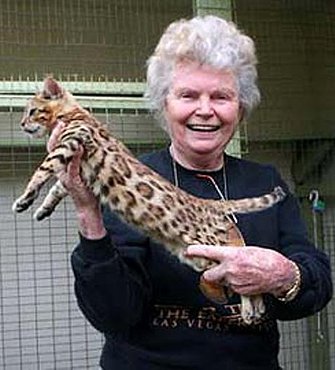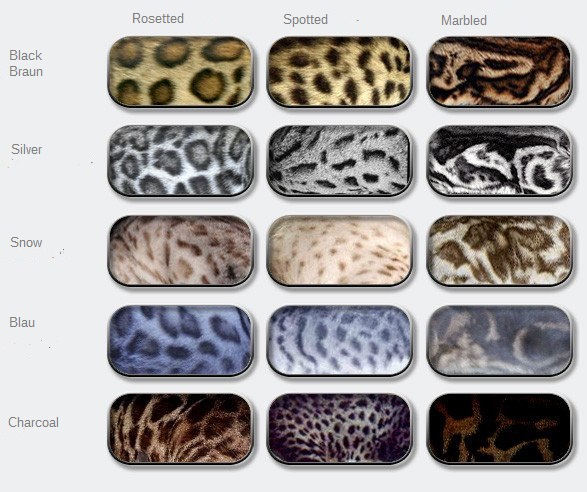Bengal Cats

The Bengal is a domestic cat breed developed to look like exotic jungle cats such as leopards, ocelots, margays and clouded leopards. Bengal cats were developed by the selective breeding of domestic cats crossed then backcrossed and backcrossed once more with hybrids from the Asian leopard cat (ALC) and domestic cat, with the goal of creating a confident, healthy, and friendly cat with a highly contrasted and vividly marked coat.
The name "Bengal cat" was derived from the taxonomic name of the Asian leopard cat (P. b. bengalensis). They have a "wild" appearance with large spots/rosettes/arrowheads, and a light/white belly, and a body structure reminiscent of the ALC. Once separated by at least four generations from the original ALC × domestic cat crossing, the breed possesses a gentle domestic cat temperament.
Bengal cats are generally a bright orange to light brown colour, although pale or off-white "snow" Bengals also exist, and are popular among owners.
Bengals as a breed
 In the 1970s, Willard Centerwall bred ALCs with domestic cats to aid his studies in genetics because of their apparent immunity to feline leukemia. Eventually, these hybrids were given to Jean Sudgen Mill because of Centerwall's illness.
In the 1970s, Willard Centerwall bred ALCs with domestic cats to aid his studies in genetics because of their apparent immunity to feline leukemia. Eventually, these hybrids were given to Jean Sudgen Mill because of Centerwall's illness.
At the same time, Bill Engler wanted to preserve the exotic cats' genes by breeding them with house cats. Although none of today's Bengal lines originate from these cats, he chose the name "Bengal", which was accepted by the American Cat Fanciers Association (ACFA), the first registry to accept the breed.
A Bengal cat displaying spotting and rosetting pattern typical of the breed: Rosetted spots occur only on the back and sides, with stripes elsewhere.
Jean Mill was instrumental in recognition of Bengals as a breed by The International Cat Association (TICA) in 1983. Her plan was not to keep the breed as a hybrid, but to domesticate these cats by breeding them further with each other.
Greg and Elizabeth Kent were also early breeders, who developed their own line of Bengals using ALCs and Egyptian Maus. This was a very successful line and many modern Bengals will find it in their pedigree.
Appearance

Bengal cat with light belly
Bengal cats have "wild-looking" markings, such as large spots, rosettes, and a light/white belly, and a body structure reminiscent of the leopard cat. A Bengal's rosetted spots occur only on the back and sides, with stripes elsewhere. The breed typically also features "mascara" (horizontal striping alongside the eyes), and foreleg striping. The eyes of a Bengal cat are relatively large and are usually bright blue or green.
The Bengal cat is usually either classed as brown-spotted or snow-spotted (although there are more colours, brown and snow are the only colours of Bengal that the Governing Council of the Cat Fancy (UK) recognize). Within brown Bengals, there are either marble or spotted markings. Included in the spotted variation is rosetted, which consists of a spot with a dark line surrounding it. Snow Bengals are also either marble or spotted, but are also divided into blue-eyed or any other colour eyes.
The International Cat Association recognizes several Bengal colours (brown, seal lynx point, mink, sepia, silver) and patterns (spotted and marbled) for competition and shows. In the New Traits class, other colours may be shown, as well as longhairs.
Alongside other hybrid cat breeds such as the Savannah, Bengal cats are typically larger than the average house cat. Males on average weigh between 4.5–6.8 kg and females 3.6–5.4 kg.
Temperament
After three generations from the original crossing, the breed usually acquires a gentle domestic cat temperament; however, for the typical pet owner, a Bengal cat kept as a pet should be at least four generations (F4) removed from the leopard cat. The so-called foundation cats from the first three filial generations of breeding (F1–F3) are usually reserved for breeding purposes or the specialty pet home environment. Bengals are known for liking water, and require a large amount of attention to keep them happy. Bengals also enjoy playing, and have been recorded jumping over 4 feet from the ground.
Shedding and grooming
As well as being desired for their appearance, they are also known for being a breed that sheds very little. Many claim that the Bengal is a hypoallergenic breed, but this is purely anecdotal evidence, and while some people may not react, others will still have an allergic reaction to them.
Bengals are extremely efficient self-groomers, therefore they require little grooming. However, vets do recommend grooming once a week to limit shedding and keep their coat healthy.










 Our cattery is engaged in breeding of the Bengal cat breed. All our kittens grow with us, surrounded by care and attention. If you have an interest in purchase a Bengal kitten or questions about the nature of the Bengals, and life with Bengal, we will find you exactly your kitten and will gladly answer all your questions.
Our cattery is engaged in breeding of the Bengal cat breed. All our kittens grow with us, surrounded by care and attention. If you have an interest in purchase a Bengal kitten or questions about the nature of the Bengals, and life with Bengal, we will find you exactly your kitten and will gladly answer all your questions.

